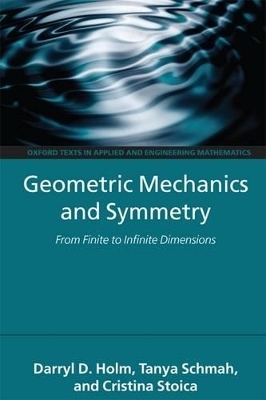
Geometric Mechanics and Symmetry
Oxford University Press (Verlag)
978-0-19-921291-0 (ISBN)
Classical mechanics, one of the oldest branches of science, has undergone a long evolution, developing hand in hand with many areas of mathematics, including calculus, differential geometry, and the theory of Lie groups and Lie algebras. The modern formulations of Lagrangian and Hamiltonian mechanics, in the coordinate-free language of differential geometry, are elegant and general. They provide a unifying framework for many seemingly disparate physical systems, such as n–particle systems, rigid bodies, fluids and other continua, and electromagnetic and quantum systems.
Geometric Mechanics and Symmetry is a friendly and fast-paced introduction to the geometric approach to classical mechanics, suitable for a one- or two- semester course for beginning graduate students or advanced undergraduates. It fills a gap between traditional classical mechanics texts and advanced modern mathematical treatments of the subject. After a summary of the necessary elements of calculus on smooth manifolds and basic Lie group theory, the main body of the text considers how symmetry reduction of Hamilton's principle allows one to derive and analyze the Euler-Poincaré equations for dynamics on Lie groups.
Additional topics deal with rigid and pseudo-rigid bodies, the heavy top, shallow water waves, geophysical fluid dynamics and computational anatomy. The text ends with a discussion of the semidirect-product Euler-Poincaré reduction theorem for ideal fluid dynamics.
A variety of examples and figures illustrate the material, while the many exercises, both solved and unsolved, make the book a valuable class text.
Darryl D Holm spent thirty four years at Los Alamos National Laboratory before moving in 2005 to Imperial College London as Professor of Applied Mathematics. During his career, Darryl developed a wide range of applications of the geometric approach to dynamical systems. His main interest is in deriving and analyzing nonlinear evolution equations for multiscale phenomena. Applications of these equations have ranged from nonlinear optical pulses used in telecommunications, to turbulence modeling for global ocean circulation and climate prediction, to template matching for the shapes of biomedical images, to directed self-assembly in nanoscience. The solution behavior of these equations includes solitons (governed by the Camassa-Holm equation), vortices and turbulence (modelled by the LANS-alpha equation) and emergent singularities (modelled by the EPDiff equation) representing the sharp edges that appear in biomedical images. Tanya Schmah completed her PhD in mathematics in 2001 at the Swiss Federal Institute of Technology in Lausanne. She has held lectureships at the University of Warwick (U.K.) and Macquarie University (Australia), and is currently working in the Department of Computer Science at the University of Toronto. She has a wide range of interests in mathematics and computer science, including symmetric Hamiltonian systems and machine learning. Cristina Stoica has a Diploma in Mathematics-Mechanics from the University of Bucharest (1991) and possesses a Doctor of Sciences degree in Astronomy awarded by the Astronomical Institute of the Romanian Academy (1997). She also holds a PhD in Applied Mathematics from the University of Victoria, Canada (2000). Currently she is a faculty member at Wilfrid Laurier University, Canada. Her main interests lie at the intersection of dynamical systems and mathematical physics.
PREFACE; ACKNOWLEDGEMENTS; PART I; PART II; BIBLIOGRAPHY
| Erscheint lt. Verlag | 30.7.2009 |
|---|---|
| Reihe/Serie | Oxford Texts in Applied and Engineering Mathematics ; 12 |
| Zusatzinfo | 32 line illustrations and 4 halftones |
| Verlagsort | Oxford |
| Sprache | englisch |
| Maße | 155 x 233 mm |
| Gewicht | 791 g |
| Themenwelt | Mathematik / Informatik ► Mathematik ► Analysis |
| Mathematik / Informatik ► Mathematik ► Angewandte Mathematik | |
| Mathematik / Informatik ► Mathematik ► Geometrie / Topologie | |
| Naturwissenschaften ► Physik / Astronomie ► Strömungsmechanik | |
| ISBN-10 | 0-19-921291-0 / 0199212910 |
| ISBN-13 | 978-0-19-921291-0 / 9780199212910 |
| Zustand | Neuware |
| Haben Sie eine Frage zum Produkt? |
aus dem Bereich


